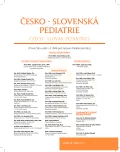Recurrent urinary tract infection – benefit of the diagnosis and treatment of voiding dysfunction
Authors:
H. Flögelová 1; L. Stašková 1; K. Michálková 2
Authors‘ workplace:
Dětská klinika Fakultní nemocnice a Lékařská fakulta Univerzity Palackého, Olomouc
1; Radiologická klinika Fakultní nemocnice a Lékařská fakulta Univerzity Palackého, Olomouc
2
Published in:
Čes-slov Pediat 2017; 72 (1): 11-14.
Category:
Toto sdělení bylo prezentováno jako přednáška na konferencích: 37. pracovní dny dětské nefrologie a 27. výroční setkání dětských urologů 19.–21. 5. 2016 v Olomouci a 9. Slovenská konferencia pediatrickej nefrológie 2.–3 .6. 2016 v Trenčianských Tepliciach.
Overview
The risk factors for recurrent urinary tract infection vary by age and thus, the diagnostic and treatment approach should vary accordingly. Whereas the main risk factor in children under 2 years of age is vesicoureteral reflux, in girls able to control their voiding (older than 3 years of age), recurrent urinary tract infection is more frequently caused by lower urinary tract dysfunction. At this age, noninvasive urodynamic testing is preferred to voiding cystourethrography. The former comprises filling in an intake and voiding diary for 2–4 days, measuring bladder wall thickness and post-void residual volume, and uroflowmetry. Based on noninvasive urodynamic testing results, daily measures and/or medication therapy are recommended.
Key words:
recurrent urinary tract infection, voiding dysfunction, intake and voiding diary, uroflowmetry, post-void residual volume
Sources
1. Beetz R. May we go on with antibacterial prophylaxis for urinary tract infections? Pediatr Nephrol 2006; (21): 5–13.
2. DeMuri GP, Wald ER. Imaging and antimicrobial prophylaxis following the diagnosis of urinary tract infection in children. Pediatr Infect Dis J 2008 Jun; 27 (6): 553–554.
3. Roberts KB, Subcommittee on Urinary Tract Infection, Steering Committee on Quality Improvement and Management. Urinary tract infection: clinical practice guideline for the diagnosis and management of the initial UTI in febrile infants and children 2 to 24 months. Pediatrics 2011 Sep; 128 (3): 595–610. doi: 10.1542/peds.2011-1330.
4. Janda J, Bébrová E, Bláhová K, Seeman T. Infekce močových cest a vezikoureterální reflux. In: Seeman T, Janda J. Dětská nefrologie. 1. vyd. Praha: Mladá fronta, 2015: 227–260.
5. Nørgaard JP, van Gool JD, Hjälmås K, et al. Standardization and definitions in lower urinary tract dysfunction in children. International Children‘s Continence Society. Br J Urol 1998 May; 81 (Suppl 3): 1–16.
6. Schultz-Lampel D. Pathophysiologie und Diagnostik der funktionellen Blasenentleerungsstörung. Urologe A 1999 Jan; 38 (1): 14–19.
7. Neuwirth J, Eliáš P. Kompendium diagnostického zobrazování dětí, adolescentů, plodů a matek. 1. vyd. Praha: Triton, 2014: 665–666.
8. Austin PF, Bauer SB, Bower W, et al. The standardization of terminology of lower urinary tract function in children and adolescents: Update report from the Standardization Committee of the International Children‘s Continence Society. Neurourol Urodyn 2016 Apr; 35 (4): 471–481.
9. Salo J, Uhari M, Helminen M, et al. Cranberry juice for the prevention of recurrences of urinary tract infections in children: a randomized placebo-controlled trial. Clin Infect Dis 2012 Feb 1; 54 (3): 340–346.
Labels
Neonatology Paediatrics General practitioner for children and adolescentsArticle was published in
Czech-Slovak Pediatrics

2017 Issue 1
Most read in this issue
- Haemophilus diseases in ENT in children before and after the introduction of Haemophilus influenzae type b vaccine
- Repeated gastrointestinal bleeding
- General Movements – examination of immature nervous system
- Guideline for the Neurodiagnostic Evaluation of the Child With a Simple Febrile Seizure. Adapted Clinical Practice Guideline of the American Academy of Pediatrics
